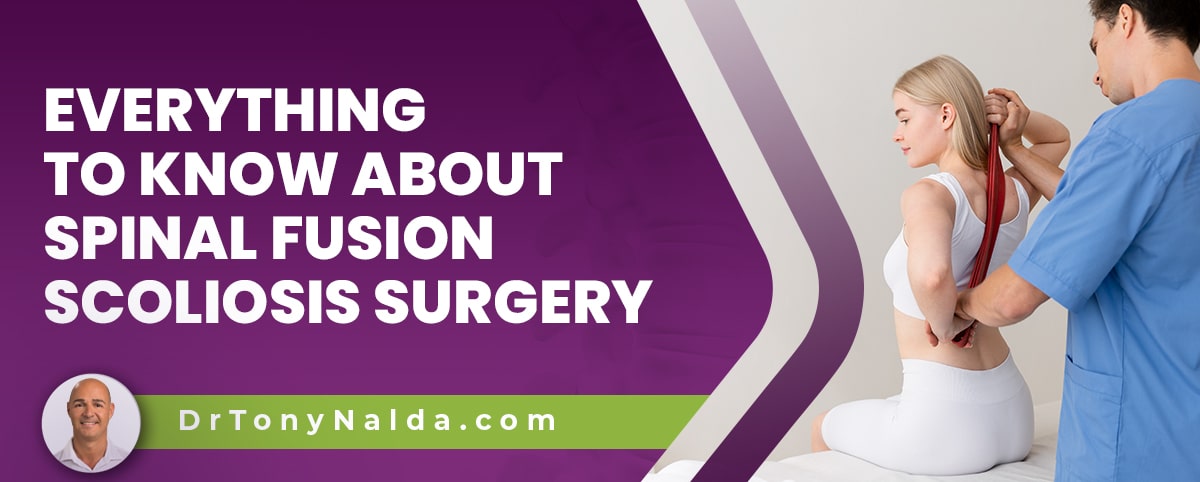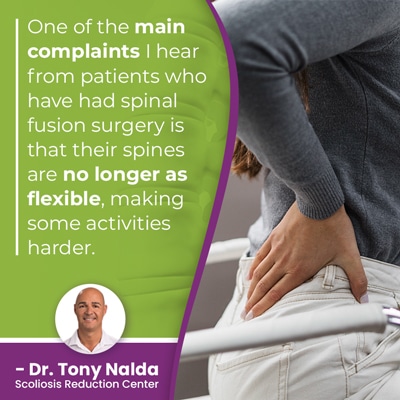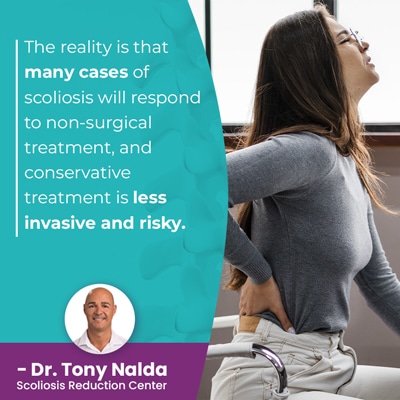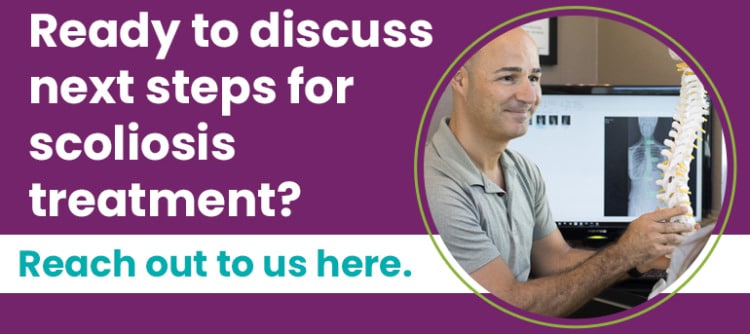Everything to Know About Spinal Fusion Scoliosis Surgery

There is a lot to know about spinal fusion surgery, including short-term effects and potential long-term effects. Every surgical procedure comes with its share of risks, and these involve risks associated with the procedure itself and the long-term effects of living with a fused spine.
What you need to know about spinal fusion surgery for scoliosis is that not all scoliosis patients need surgical treatment; in fact, with early detection and intervention in typical cases, most patients respond well to non-surgical conservative treatment options.
Before getting to the specific pros and cons of spinal fusion surgery, let's talk about the two main treatment approaches patients have to choose from: traditional and conservative.
Table of Contents
Scoliosis Treatment Options
If an unnatural sideways-bending and twisting spinal curve develops, patients need to understand that as a progressive condition, the nature of scoliosis is to get worse over time, and this means the size of the unnatural spinal curve is increasing, as are its effects.
As a progressive condition, scoliosis can range from mild scoliosis to moderate scoliosis to severe and very severe cases.
Scoliosis treatment is shaped by a number of important factors: patient age, condition type, condition severity, and curvature location; these are the factors that conditions are classified around and informs the crafting of effective treatment plans.
Traditional treatment was the dominant choice for many years and commonly involves watching and waiting, as a recommendation for mild cases, and for patients that become severe and/or in atypical scoliosis cases, spinal fusion surgery is commonly recommended.
Traditional treatment is described more as reactive than proactive because it's more about responding with treatment once a certain amount of progression has already occurred.
When/if a patient on the path of traditional treatment becomes severe, spinal fusion surgery is commonly recommended as the best remaining recourse, but in many of these cases, patients weren't presented with any other option earlier.
Spinal Fusion Surgery
Spinal fusion surgery for scoliosis has the goal of straightening the spine and stopping progression.
Spinal fusion surgery is costly, invasive, and can come with some serious potential risks and side effects.
The procedure itself involves identifying the curve's most-tilted vertebrae at its apex and fusing them so they become one solid bone, often removing the intervertebral discs that sit between adjacent vertebrae to be fused.
Once these vertebrae are fused, the idea is that they can't become more unnaturally tilted over time (progress), and metal rods are often attached to the spine with pedicle screws to hold it in position.
So while spinal fusion surgery can certainly stop progression and make a bent spine straighter, does it cost the spine in other ways?
Loss of Flexibility and Range of Motion
 One of the main complaints I hear from patients who have had spinal fusion surgery is that their spines are no longer as flexible, making some activities harder.
One of the main complaints I hear from patients who have had spinal fusion surgery is that their spines are no longer as flexible, making some activities harder.
A spine that's fused is contrary to its movement-based design so likely won't be as flexible; the more vertebrae fused, the more likely a noticeable loss in range of motion is.
Back Pain
Having a reduced range of motion in the spine usually means a spine that's more rigid, and this can also mean an increase in back pain, particularly around the fusion site.
Back pain isn't always a part of life with scoliosis, particularly in childhood scoliosis as the condition doesn't become compressive until skeletal maturity has been reached.
Once spinal growth has stopped, there is nothing to counteract the compressive force of the unnatural spinal curvature, and if the fused portion of the spine is more painful, an increase in back pain can be an effect of spinal fusion surgery.
A Spine that's Weaker
A spinet that's fused is a spine that's weaker and more vulnerable to injury, and patients need to be aware of this.
Each patient will respond to spinal fusion surgery in their own way, depending on severity, type, location of the fusion, and the number of vertebrae fused.
Procedural Risks
There are also risks associated with the procedure itself: nerve damage, infection, excessive blood loss, and adverse reaction to hardware used.
If there is a complication during the procedures, recovery time spent in the hospital room will increase.
So what patients need to know about spinal fusion surgery for scoliosis is that it's not always necessary, particularly with early detection and intervention.
Spinal Fusion Surgery Alternatives
There are never treatment guarantees, but as a progressive condition that becomes more severe over time, the sooner treatment is started, the better.
Scoliosis that's diagnosed early means treatment can be started early. Mild scoliosis can be highly responsive and is easier to treat than mild, severe, and very severe scoliosis, so the goal is to diagnose and treat scoliosis while mild.
It's not always easy to diagnose scoliosis early, particularly in children for whom the condition isn't commonly painful.
The main sign of scoliosis in children is postural deviation; the earliest signs often include uneven shoulders and hips.
In addition to postural changes, disruptions to gait, balance, and coordination are also common.
 The reality is that many cases of scoliosis will respond to non-surgical treatment, and conservative treatment is less invasive and risky.
The reality is that many cases of scoliosis will respond to non-surgical treatment, and conservative treatment is less invasive and risky.
Conservative treatment is integrative and innovative and its results show just how unnecessary surgery can be in many cases.
Chiropractic-Centered Approach
Here at the Scoliosis Reduction Center®, the approach is proactive, conservative, and chiropractic-centered.
Also known as functional treatment because it works towards preserving as much of the spine's natural strength and function as possible, conservative treatment can work towards reducing the size of the unnatural spinal curve, improving spinal alignment, balance, and stability.
If the spine is off balance and unstable so is the body, and the goal of conservative treatment is to correct the scoliosis to prevent progression and the need for invasive scoliosis surgery.
Spinal bones can be manually adjusted back into alignment with the rest of the spine, and this is addressing the condition's underlying structural nature.
If a curvature reduction is successful, the condition's uneven forces are also reduced, which is the underlying cause of the condition's effects.
But a spine's healthy curves need to be supported by strong muscles, and this is where physical therapy and scoliosis exercises come in.
Physical Therapy
Physical therapists who specialize in scoliosis understand the spine and how scoliosis affects it.
It's not just the spine that's in charge of maintaining its natural curves and alignment, it's also the role of the spine's surrounding muscles to provide spinal support and stability.
Scoliosis-specific physical therapy and exercise-based approaches to addressing scoliosis can help strengthen and balance the spine's surrounding muscles.
Scoliosis affects the body in a number of ways, including a muscular imbalance; the spine's surrounding muscles struggle to support an unnaturally-curved and rotating spinal curve, and an imbalance can develop as the muscles on one side of the spine become stretched and sore from overuse and muscles on the opposite side can become weak from under-use.
Physical therapy can also improve spinal flexibility, making it more responsive to treatment, posture and brain-body communication.
There are many different types of scoliosis, but children are most often diagnosed, and adolescent idiopathic scoliosis is the most prevalent type overall.
Corrective Bracing
Corrective bracing can help by pushing the spine into a straighter alignment, and as growing spines are more malleable, corrective bracing is commonly used when treating childhood scoliosis.
Adolescent idiopathic scoliosis patients are the most at risk for rapid progression because of the rapid and unpredictable growth spurts of puberty, and a corrective brace like the ScoliBrace, if worn as prescribed, can be a valuable facet of treatment.
Rehabilitation
As an progressive condition, scoliosis treatment is about how best to address an ongoing condition, and to prevent ongoing back pain (adult scoliosis), rehabilitation has to further heal and stabilize the spine; this can involve the prescription of scoliosis-specific exercises that can be performed at home.
Continued chiropractic care and lifestyle guidance can also be important parts of rehabilitating the spine for long-term sustainable treatment results.
Conclusion
While there is still a place for spinal fusion surgery in severe and/or atypical cases of scoliosis, many patients don't need surgical intervention.
While scoliosis surgery can straighten a bent spine, it can cost the spine in terms of its strength and flexibility.
In addition, once a spine is fused, it's fused for life, and a fused spine is weaker and more vulnerable to injury.
If hardware should fail in any way, the only recourse is more surgery, and of course, the younger a patient is at the time of their spinal fusion surgery, the longer the hardware has to perform optimally inside the body, and for older patients, the risks of surgery only increase with age and each subsequent procedure.
Here at the Center, patients benefit from a less-invasive conservative approach to scoliosis treatment and having access to multiple different types of treatment under one roof.
If scoliosis is left untreated, it's likely to continue progressing and become severe, but if proactive treatment is applied early in a condition's progressive line, improvements can be made that include reducing the scoliosis on a structural level, increasing the spine;s surrounding muscles strength, and further healing and rehabilitating the spine.
Scoliosis complications can include chronic pain, sciatic nerve pain, disruptions to lung function and digestive issues, but particularly with early diagnosis and intervention, progression and the need for spine surgery can be avoided.
Dr. Tony Nalda
DOCTOR OF CHIROPRACTIC
After receiving an undergraduate degree in psychology and his Doctorate of Chiropractic from Life University, Dr. Nalda settled in Celebration, Florida and proceeded to build one of Central Florida’s most successful chiropractic clinics.
His experience with patients suffering from scoliosis, and the confusion and frustration they faced, led him to seek a specialty in scoliosis care. In 2006 he completed his Intensive Care Certification from CLEAR Institute, a leading scoliosis educational and certification center.
About Dr. Tony Nalda
 Ready to explore scoliosis treatment? Contact Us Now
Ready to explore scoliosis treatment? Contact Us Now





